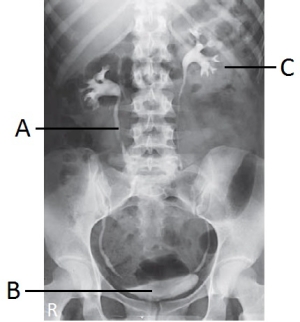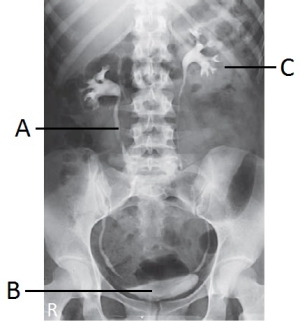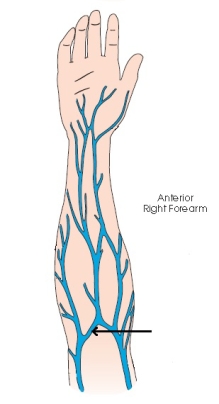A) behind the peritoneum.
B) behind the stomach.
C) inside the peritoneum.
D) inside the peritoneal cavity.
Correct Answer

verified
Correct Answer
verified
Multiple Choice
What is the central-ray angulation for the AP axial urinary bladder?
A) 0 degrees
B) 10 degrees
C) 10 to 15 degrees caudad
D) 10 to 15 degrees cephalad
Correct Answer

verified
Correct Answer
verified
Multiple Choice
What anatomy is labeled with the letter A shown in the image from an IVU examination below?

A) Left ureter
B) Right ureter
C) Left renal pelvis
D) Right renal pelvis
Correct Answer

verified
Correct Answer
verified
Multiple Choice
Letter B shown in the image from an IVU examination below labels the:

A) right renal pelvis.
B) right ureter.
C) urinary bladder.
D) symphysis pubis.
Correct Answer

verified
Correct Answer
verified
Multiple Choice
The microscopic components of the parenchyma of the kidney are called:
A) nephrons.
B) calyces.
C) the glomerulus.
D) cortical substances.
Correct Answer

verified
Correct Answer
verified
Multiple Choice
How much will the kidneys drop in the change from the supine to the upright position?
A) 1 inch
B) 2 inches
C) 3 inches
D) 3 inches
Correct Answer

verified
Correct Answer
verified
Multiple Choice
Contraindications for intravenous urography include: 1) anuria. 2) renal failure. 3) elderly patients.
A) 1 and 2
B) 1 and 3
C) 2 and 3
D) 1, 2, and 3
Correct Answer

verified
Correct Answer
verified
Multiple Choice
The abbreviation for the excretory technique of urography is:
A) IVP.
B) EXU.
C) KUB.
D) IVU.
Correct Answer

verified
Correct Answer
verified
Multiple Choice
How is the central ray positioned to free the bladder neck of superimposition during a female cystourethrogram?
A) 0 degrees
B) 5 degrees caudad
C) 5 degrees cephalad
D) 10 degrees cephalad
Correct Answer

verified
Correct Answer
verified
Multiple Choice
Which of the following is true regarding retrograde urography? 1) The ureters must be catheterized. 2) The exam provides little physiologic information. 3) Contrast is injected directly into the pelvicalyceal system.
A) 1 and 2
B) 1 and 3
C) 2 and 3
D) 1, 2, and 3
Correct Answer

verified
Correct Answer
verified
Multiple Choice
For which body habitus will the kidneys lie at the highest level?
A) Sthenic
B) Asthenic
C) Hypersthenic
D) Hyposthenic
Correct Answer

verified
Correct Answer
verified
Multiple Choice
What vein, often used for venipuncture, is labeled with the arrow in the diagram below?

A) Basilic vein
B) Cephalic vein
C) Radial vein
D) Median cubital vein
Correct Answer

verified
Correct Answer
verified
Multiple Choice
Where is the IR centered for the AP oblique projection during a male or female cystourethrogram?
A) Superior border of the pubic symphysis
B) 2 inches above the pubic symphysis
C) 2 inches below the pubic symphysis
D) Variable depending on the penis position
Correct Answer

verified
Correct Answer
verified
Multiple Choice
A radiographic examination of the urinary bladder is termed:
A) cystography.
B) cystourethrography.
C) cystoureterography.
D) retrograde urography.
Correct Answer

verified
Correct Answer
verified
Multiple Choice
The respiration phase for radiographic images made during intravenous urography is:
A) suspended inspiration.
B) suspended expiration.
C) suspended respiration.
D) slow breathing.
Correct Answer

verified
Correct Answer
verified
Multiple Choice
A calculation that uses the creatinine level, age, race, gender, and body size, and is the best overall indicator of kidney function is:
A) glomerular filtration rate.
B) blood urea nitrogen level.
C) creatine-plus rate.
D) kidney function indicator.
Correct Answer

verified
Correct Answer
verified
Showing 81 - 96 of 96
Related Exams